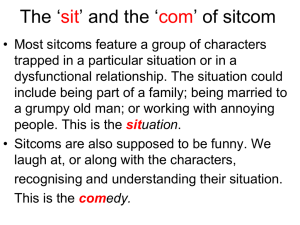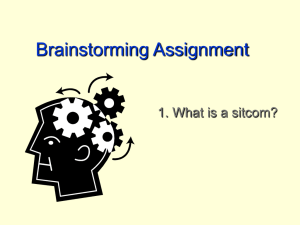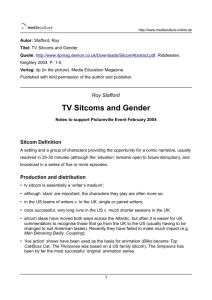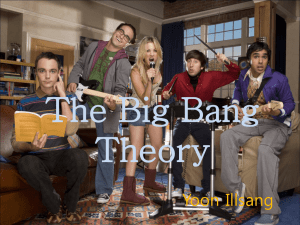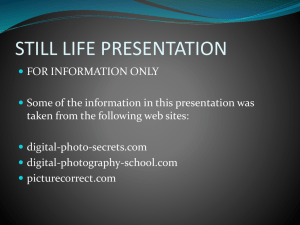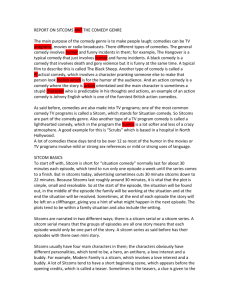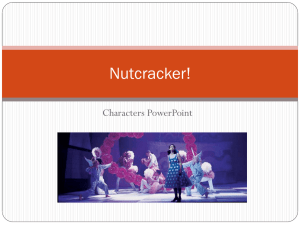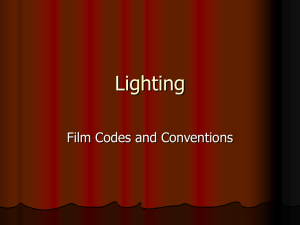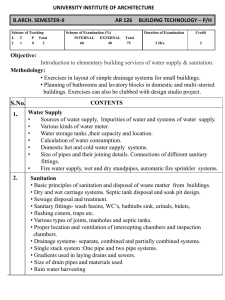Codes and Conventions
advertisement
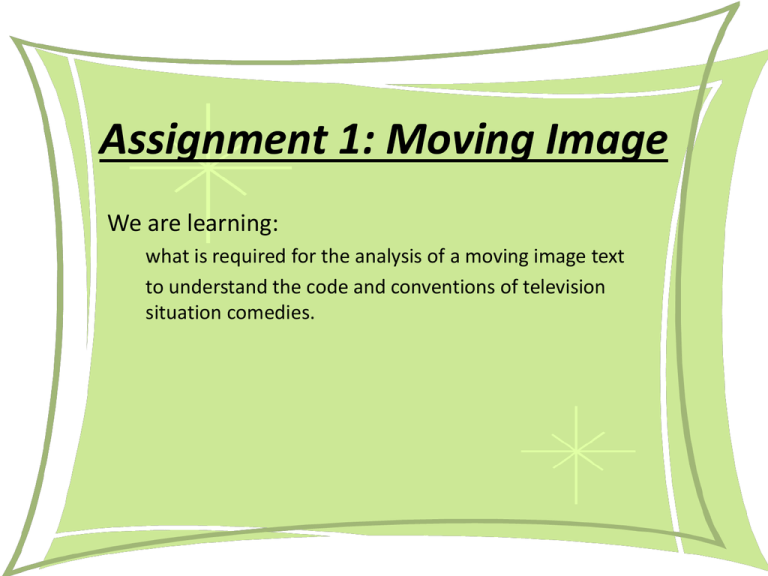
Assignment 1: Moving Image We are learning: what is required for the analysis of a moving image text to understand the code and conventions of television situation comedies. Breakdown and Expectations For this controlled assessment, you will be expected to demonstrate the following (in no more than 500 words): • Write about the typical code and conventions of the clip. • Show understanding of aspects of media language (using key terms). • Say something about the way the characters are represented. • Consider the effect on the audience. KEY WORDS • FOURTH WALL: when filmed in a TV studio, a sitcom will usually only show 3 walls, the camera and the audience will therefore always occupy the fourth wall (voyeurism). • HIGH KEY: very bright lighting which creates a glossy look that can give a glamorous feel but may seem artificial. • ESTABLISHING SHOT: to show the audience a change of location, a still shot of the exterior of a location will be shown. Mise en Scene A French term meaning what is put into a scene or frame. These aspects can communicate essential information to the audience; how they are supposed to feel or react to different media. We are going to deconstruct different images today, looking at what the mise-en-scene suggests about the narrative. 1. 2. 3. 4. 5. Settings & Props Costume, Hair & Make Up Facial Expressions & Body Language Lighting & Colour Positioning of characters/objects within the frame Each aspect of mise-en-scene has hidden meanings and sends signals to the audience about how we are supposed to feel at a certain point. 1. Settings & Props Settings & Locations play an important part in film-making and are not just ‘backgrounds’ Most sitcoms are filmed indoors, making them cheaper to produce. Sets are built in a TV studio, which gives a controlled environment and means they can be used repeatedly. Settings can manipulate an audience by building certain expectations and then taking a different turn What do the props and setting suggest about the narrative of this sitcom? 2. Costume, Hair & Make Up • Costume, Hair & Make Up act as an instant indicator to us of a character’s personality, status and job. • It tells us immediately whether the film is set in the present and what society/or culture it will centre around. • Certain costumes can signify certain individuals i.e. black cloak of a vampire, Spidey’s Spiderman suit. • In sitcoms, the way characters are dressed generally appears realistic; why do you think this is? What does the costume, hair and make up suggest about the characters in this sitcom? 3. Facial Expressions & Body Language • Facial Expressions provide a clear indicator of how someone is feeling • If someone is smiling broadly, we assume they are happy but we may get a different feeling if this is accompanied by scary music • Body Language may also indicate how a character feels towards another character or may reflect the state of their relationship • TASK: What meanings/emotions doe the following image convey? What meanings/emotions does the following image convey? 4. Positioning of Characters & Objects within a frame • Positioning within a frame can draw our attention to an important character/object. • A film-maker, producer or director can use positioning to indicate relationships between people. • TASK: What does the positioning in the following images reveal about the characters/sitcom? What does the positioning in this image reveal about the characters/sitcom? 6. Lighting & Colour Lighting & Colour can be used to achieve a variety of effects: • To highlight important characters or objects within the frame • To make characters look mysterious by shading sections of the face & body • To reflect a characters mental state/hidden emotions (i.e. bright = happy, dark = disturbed, strobe effect = confused) High key lighting Low key lighting Take a look at this sitcom still – what does the miseen-scene suggest about the overall narrative? 1. Settings & Props 2. Costume, Hair & Make Up 3. Facial Expressions & Body Language 4. Lighting & Colour 5. Positioning of characters within the frame Why do we watch Sitcoms? Remember Blumler and Katz’s theory? Well, which might apply to the use of Sitcoms? To be informed and educated. To identify with characters and situations. To be entertained. To socially interact with others - ‘the water-cooler moment’. To escape from daily troubles and woes. Gratification – the opportunity to feel good about themselves. What is a ‘sitcom’? • In order to qualify as a sitcom, a programme will need to use typical generic conventions associated with the sitcom ‘code’. – – – – Normally about the ‘real world’. Usually set in domestic or work settings. Operates in a confined society. Most plots are created by a tension between two characters and the situation (hence the ‘sit’) they find themselves in. – The characters have aspirations and hopes that are unrealistic and pretentious. – The tension is never finally resolved, though temporary relief is provided by laughter (hence the ‘com’). – The audience will know that the same problem will resurface next week. Sitcoms: the ‘conventions’ • Setting: most sitcoms are filmed indoors, making them cheaper to produce. Sets are built in a TV studio, which gives a controlled environment and means they can be used repeatedly. • Characters: small group of main characters appear in every episode; other characters appear in supporting roles. They appear quite often but their importance is only seen in terms of how they affect the main characters. • Lighting: while supposedly ‘realistic’ or naturalistic lighting it is often high key and quite bright so the show will appear more colourful than in real life. This makes the appearance of the show seem more attractive. British – low key, American – high key. Sitcoms: the ‘conventions’ • Mise-en-Scene: the way the characters are dressed, the décor and furnishings will all appear realistic; it is something the audience can relate to and something that they know. • Editing: continuity editing is used; the editing of the shots will seem to naturally follow the progress of a particular scene. • Camera Work: most will begin with an establishing shot before being followed by a long shot or medium shot to show us which characters are involved and what they are doing. Most of the shots in a sitcom will be medium shots, to focus the story and allow the audience to understand the dialogue. Task • Create your own ‘research’ sheet including the information about the code and key conventions of sitcoms. • It should contain information (and can be illustrated with stills from sitcoms you watch) with information about the code and the key conventions. • This should be presented and printed as a ‘research’ board and will be used as part of your controlled assessment (shows evidence of research into this media). Things to include: • • • • • • • Setting Characters Lighting Mise en scene Editing Camera work Typical plots/storylines Most sitcoms are filmed indoors, making them cheaper to produce. Sets are built in a TV studio, which gives a controlled environment and means they can be used repeatedly. A small group of main characters appear in every episode; other characters appear in supporting roles. They appear quite often but their importance is only seen in terms of how they affect the main characters. while supposedly ‘realistic’ or naturalistic lighting it is often high key and quite bright so the show will appear more colourful than in real life. This makes the appearance of the show seem more attractive. British – low key, American – high key. Stretch Activity We say that we ‘watch’ a television programme but we also hear it. There is dialogue, incidental music and sound effects included in there as well. In many sitcoms, there also may be ‘canned laughter’. What effect on viewers would canned laughter have? Plenary - What could we say about the following for the general expectations of a sitcom? • Setting • Characters • Lighting • Mise-en-scene • Camera Work • Editing How I Met Your Mother (Channel 4) How I Met Your Mother is the hilarious story of how hopeless romantic Ted fell in love with the mother of his two children. The flashback shenanigans begin when Ted's best friend Marshall proposes to long term girlfriend Lily which makes Ted feel unloved enough to do something about it. Helping him in his mission to find a ladylove is wellsuited toxic bachelor Barney and serving as his main object of affection is feisty news anchor Robin. An older, wiser Ted narrates the story to his two children as along with us, they try to work out where their mother fits into all of the bumbling, fumbling and general silliness. What could we say about the following … • Setting • Characters • Lighting • Mise-en-scene • Camera Work • Editing My Family (BBC) Sitcom about a dentist and his family. An unusual request from a couple whom Susan and Ben met on holiday leads to chaos in the Harper household, and Susan finally discovers who Kenzo's father is. What could we say about the following … • Setting • Characters • Lighting • Mise-en-scene • Camera Work • Editing
